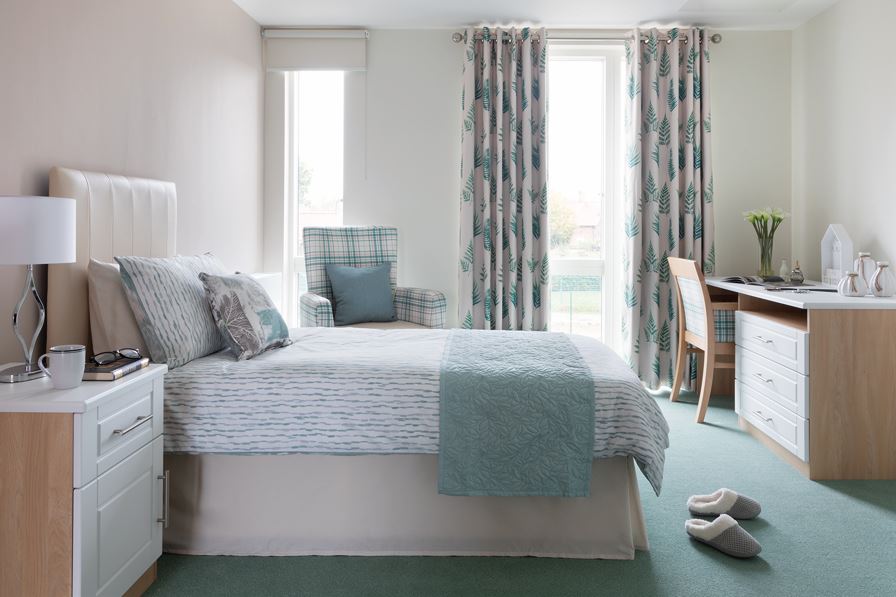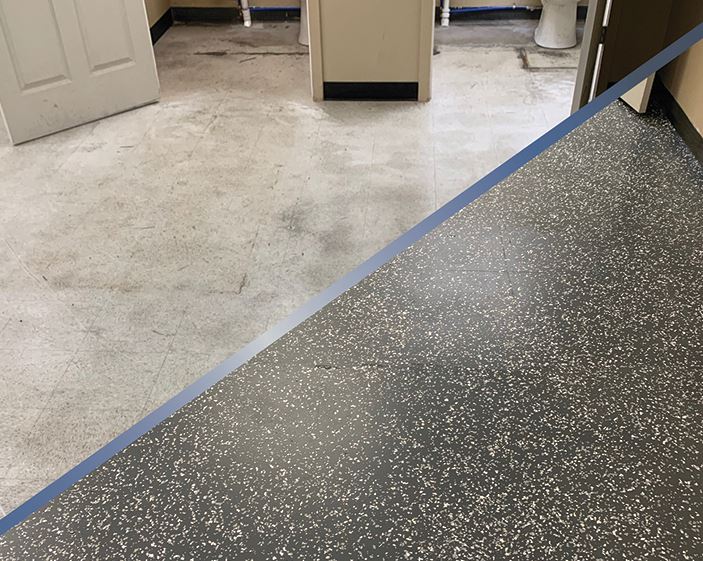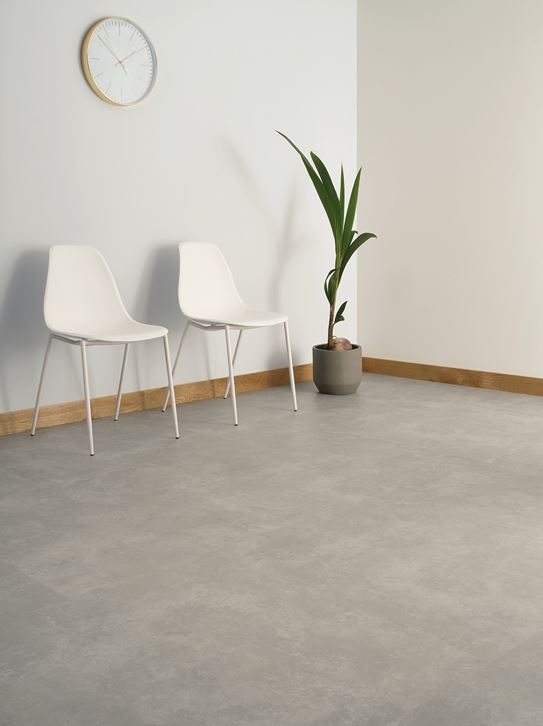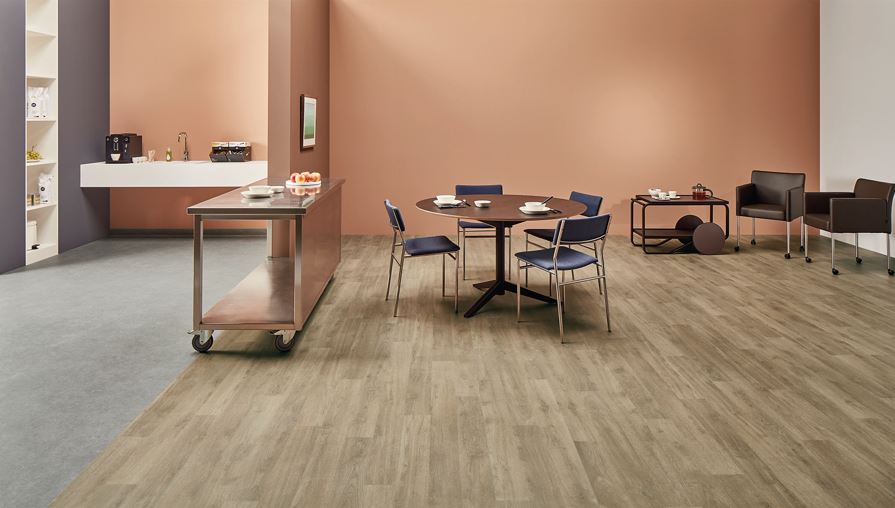
People living with dementia are twice as likely to slip or fall, and three times more likely to incur a serious injury as a result, compared to those without the condition.
So, ensuring dementia care environments are designed to take account of, and minimise, this risk is paramount. And one area of focus for many architects and interior designers is flooring. Louisa Eyles, head of commercial marketing at flooring manufacturer, Amtico, explains: “Dementia symptoms include impairments such as cognition, vision changes, reduced colour and depth perception, and restricted mobility, so flooring is an essential part of dementia care facilities – and one of the most important elements to get right.” Gemma Hart, specifications manager at Altro, adds: “The effect of falls on an older person can be devastating. “So, when considering how to minimise falls in care environments, we need to start by understanding how physical frailty and the dulling of senses associated with the normal ageing process affect how we interact with our environment.” And, for people with dementia, there are a number factors which increase the risk of a fall. Firstly, they are more likely to experience problems with mobility, balance, and muscle weakness.
REDUCING THE RISKS
In addition, hallucinations and not being able to make sense of the world around them can lead to confusion, isolation, and a lack of confidence in navigating an environment, which can also lead to an increased risk. Furthermore, medications that are used to treat the symptoms of dementia can put residents at a greater risk of falling as common side effects can cause drowsiness, dizziness, and postural hypotension, which is a drop in blood pressure when you stand up. Therefore, selecting the right flooring for care environments is crucial to resident and patient wellbeing.
COLOUR
Catherine Helliker, marketing manager at Danfloor, said colour and contrast are one of the most-important considerations when choosing flooring products. She added: “Understanding and using Light Reflectance Values (LRVs) is essential when designing an interior that is easy to navigate and creates no barrier to movement.” LRV is a measure of the percentage of visible and usable light that is reflected from a surface when illuminated by a light source. It tells you how much light a colour reflects, and conversely how much it absorbs, and runs on a scale of 0%-100%, where zero is assumed to be black and 100% a perfectly-reflective white. And LRVs are particularly important when designing interiors for people living with dementia as they often experience a reduction in contrast perception and perceived saturation or vividness of colour. “Someone with dementia may see colours with LRVs that sit within an eight point difference as the same colour,” said Helliker. “Colours with a difference of more than eight points will be seen as contrasting and LRVs with a difference of 30 points or more will be easily distinguished. “The 30-point difference, therefore, can help with wayfinding and navigation.” But there is a fine line between too little contrast and too much. “A fear of using the bathroom or ensuite facility, for example, could be down to several factors, such as the colour or texture of the floor,” said Helliker. “If the colour of the bedroom carpet has an LRV of 30 and the flooring within the ensuite bathroom has an LRV of eight this would equate to a 22-point difference. “A person living with dementia may feel safe and secure in their bedroom, but when expected to use the bathroom they may feel like they are crossing over into a black hole, purely down to the colours of the two surfaces.” Lewis Cooper, spokesman for Forbo Flooring Systems, adds: “Dark-coloured floor coverings may be seen as deep holes that should not be stepped into; while a heavily-patterned design, flecked effects, or flooring incorporating a logo could become an obstacle to be avoided. “And shiny or sparkly finishes can appear as water and therefore present a slip risk which is not really there; while transitional strips – for example between carpeted areas and hard flooring areas – might create a barrier to the eye of a resident. “The effect flooring has is different for each person living with dementia and responses may vary from agitation and panic or hallucinations, to high stepping over a perceived obstacle, resulting in over balancing and the potential for falling, or bending down to pick something off the floor that isn’t really there – again creating a needless risk of falling.” With this in mind, he advises choosing plain designs with tonal contrast to the walls and doors and matt finishes recommended to avoid any disturbing reflections.
MATERIALS
In addition to opting for the right colour for flooring, material choice is also critical. Eyles advises: “Specifying luxury vinyl tile (LVT) products, such as Amtico Signature or Spacia, ensures the flooring is nonporous, resistant to spills, and has antimicrobial properties. “Indeed, LVT is also available in safety flooring versions with enhanced slip resistance to further reduce the risk of injury to people with dementia.” Similarly, Forbo’s Surestep Laguna, Surestep Aqua, Surestep Wood, and Surestep Material safety flooring collections offer guaranteed lifetime slip resistance across a variety of designs, which have been accredited by the world-renowned Dementia Services Development Centre (DSDC) at Stirling University. The slip resistance of existing flooring materials can be enhanced through the application of coatings containing particles which increase the surface friction, said Alec Stacey, technical manager at Bona, a flooring renovation and restoration specialist.
CARPET MAKES A COMEBACK
And carpet is also making a comeback in dementia-friendly care environments, with studies showing that the softer material can reduce injuries caused by slips, trips, and falls. Research conducted by Healy studied the role of carpeted and vinyl floors in the injuries older patients receive when falling in the hospital. Out of a group of patients falling on the carpet, 17% sustained injuries, compared to 46% when falling on vinyl flooring. “Statistical analysis indicated that there was a less than 1% probability that the reduced rate of injury for those patients who fell on carpets was owing to chance,” explains Helliker. “Research also suggests that thicker carpets can decrease fracture rates, but in a care facility you must be mindful to select the correct thickness of carpet to allow for the use of walking aids and those people who tend to shuffle.” Carpet manufacturers are also concentrating their research and development efforts on ensuring products are easy to clean and designed with an impervious membrane to trap liquids and spills on the surface for easy removal.

SPECIFYING THE RIGHT SOLUTION
Offering advice to care home and hospital estates managers, Cooper said: “While careful consideration should be given to all floor coverings within a dementia care facility, maintaining a high level of slip resistance in bathrooms, wet rooms, or anywhere where food and drink is consumed it vital. “As such, it is important that appropriately-graded slip resistant flooring (safety flooring) is specified in these areas. “And, when specifying safety flooring, managers should opt for solutions where the slip resistance properties are sustainable throughout the lifecycle of the product. “It’s also worthwhile familiarising yourself with the safety flooring test methods and what those results mean in terms of contributing to the prevention of slips and trips, such as the Pendulum Test and the Ramp Test.” Eyles advises adhering to BS 8200:2018 Design of an Accessible and inclusive built environment (Part 2: Buildings – Code of Practice). And Hart told hdm: “Designing with empathy can make a huge difference to the everyday life of people living with dementia. “That means understanding how dementia affects those living with it, what that looks like to them, and why and how you can make improvements through design choices. “You’ll need to ensure you meet the legislation and guidance for dementia design, and there is a lot of useful information in those documents, plus a wealth of material from manufacturers. “A great starting point is Altro’s Design for Dementia CPD, which includes many practical examples, along with guidance and best practice examples and solutions, based on years of experience and real-world applications.”
MAINTENANCE
Ongoing maintenance is also key. Stacey said: “it is important that flooring is maintained in the correct manner to retain physical properties such as slip resistance. “Floor maintainers should be assessed to ensure that they do not negatively impact on the surface. Similarly, insufficient or incorrect maintenance may result in premature wear. “Ideally, it should be possible to refurbish the flooring to avoid long periods of downtime which may be required for future replacement. This may involve a process of stripping and recoating the flooring while retaining the physical properties of the surface.”
THE FUTURE
Moving forward, flooring manufacturers are continuing to explore the impact of colour and material choice on the safety and wellbeing of people living with dementia. Cooper said: “Many manufacturers are now working with specialist companies to develop solutions suitable for dementia-inclusive health and care environments. “For example, at Forbo, we have been working with the Dementia Services Development Centre since 2017 to review and rate our floors in relation to dementia design principles and usability within a dementia-inclusive environment. “Specifiers and designers can now choose from an extensive selection of more than 1,000 products which have been accredited across the Class 1a, 1b and 2 rating system, which is based on the tonal contrast and pattern of products and their suitability for use. “In the future these partnerships will be increasingly important to ensure solutions are developed to drive the creation of safe, inclusive spaces.” Hart concludes: “Awareness of dementia-friendly design has increased massively in recent years, as well as wider inclusive principles for design for neurodiversity. “And this awareness will continue to drive product development, allowing intelligent interior design for health and care facilities, as well as education and public areas such as bars, museums, sports facilities that could make them more accessible for all.”


